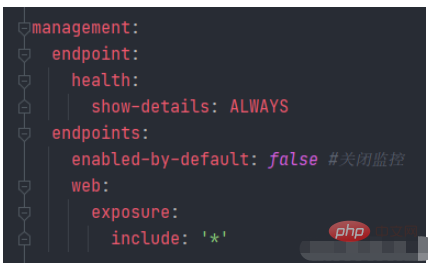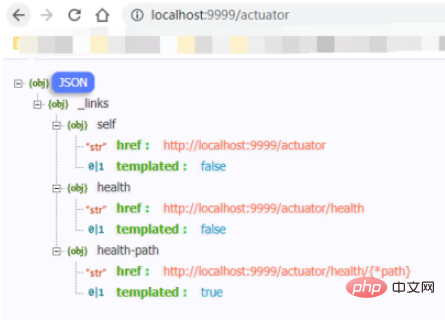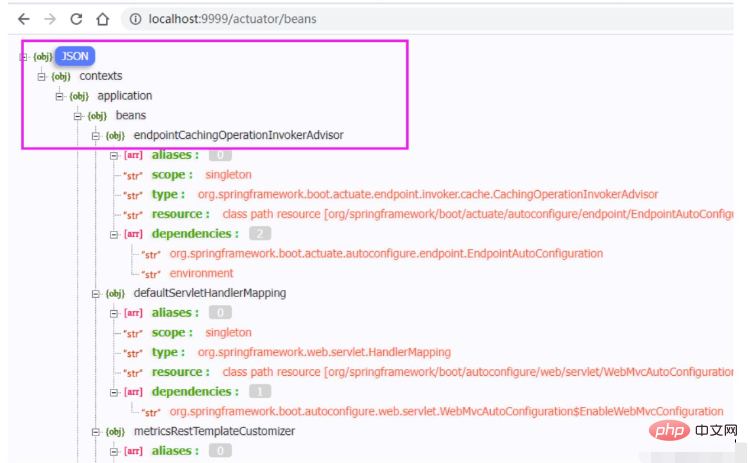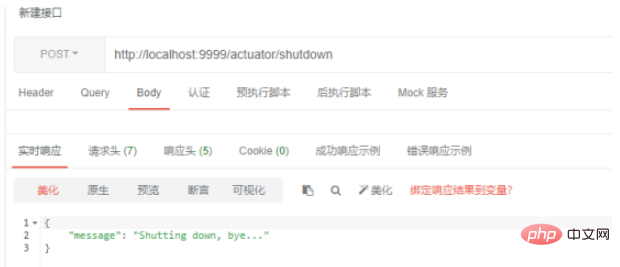Home >Java >javaTutorial >How to close actuator in SpringBoot

management:
endpoint:
health:
show-details: ALWAYS
endpoints:
enabled-by-default: false #关闭监控
web:
exposure:
include: '*'Spring Boot’s Actuator . It provides many production-grade features, such as monitoring and measuring Spring Boot applications. These features of Actuator are available through numerous REST endpoints, remote shells, and JMX.
【Usage environment】
【1】SpringBoot version 2.5.0, JDK11
【2】Service port 9999
Add dependency
<dependency>
<groupId>org.springframework.boot</groupId>
<artifactId>spring-boot-starter-actuator</artifactId>
</dependency> Start the project and access the /actuator endpoint. The SpringBoot2. Some endpoints can be set in exclude.
management:
endpoints:
web:
exposure:
include: "*"
exclude: ""Restart the project, you can see that the displayed endpoints have increased a lot
Actuator endpoint arrangement
 /autoconfig and/conditions Get auto-configuration conditions
/autoconfig and/conditions Get auto-configuration conditions
Endpoint: http://localhost:9999/actuator/conditions
##[Example]
 Check that Classpath does not require JdbcTemplate. If the condition is not met, automatic configuration will not be performed.
Check that Classpath does not require JdbcTemplate. If the condition is not met, automatic configuration will not be performed.
To understand the Spring context in the application In this case, the most important endpoint is /beans. It returns a JSON document describing each bean in the context, including its Java type and other injected beans.
Request endpoint:/actuator/beans
/env endpoint View configuration properties
 /env endpoint will Generates a list of all environment properties available to the application, whether or not they are used. This includes environment variables, JVM properties, command line parameters, and properties provided by application.properties or application.yml files.
/env endpoint will Generates a list of all environment properties available to the application, whether or not they are used. This includes environment variables, JVM properties, command line parameters, and properties provided by application.properties or application.yml files.
Endpoint:/actuator/env
/env provides some security policies to protect the privacy of configuration. In order to prevent such information from being exposed to /env, all attributes named password, secret, key (or the last paragraph of the name are these) will be added with "*" in /env, the reference is as follows:
/mappingRequest URL mapping
 /mapping endpoint displays all @RequestMapping request paths
/mapping endpoint displays all @RequestMapping request paths
Request endpoint:/actuator/mappings
[Test Interface] @GetMapping(value = "/hello", produces = "application/json;charset=utf-8")
public String hello(@RequestParam("name") String name) {
return "hello world";
}


/metrics provides us with a monitoring of runtime metrics, which can quickly check the application at runtime.
Endpoint:/actuator/metrics
The main monitoring items are as follows:
/metrics端点会返回所有的可用度量值,但你也可能只对某个值感兴趣。要获取单个值,请求时可以在URL后加上对应的键名。

如上图所示,查询jvm最大内存,结果值大约为6G。
/httptrace 追踪Web请求
/httptrace端点能报告所有Web请求的详细信息,包括请求方法、路径、时间戳以及请求和响应的头信息。
【请求端点】/actuator/httptrace
默认情况下httptrace没有启用,它要求一个HttpTraceRepository 的对象Bean.

在系统中创建如下配置,提供一个HttpTraceRepository 类型的Bean,这里选择的是InMemoryHttpTraceRepository内存存储的方式。该方式默认提供最新的100条请求记录。
import org.springframework.boot.actuate.trace.http.HttpTraceRepository;
import org.springframework.boot.actuate.trace.http.InMemoryHttpTraceRepository;
import org.springframework.context.annotation.Bean;
import org.springframework.context.annotation.Configuration;
@Configuration
public class HttpTraceActuatorConfiguration {
@Bean
public HttpTraceRepository httpTraceRepository() {
return new InMemoryHttpTraceRepository();
}
}/dump 导出线程快照
/dump端点会生成当前线程活动的快照。完整的线程导出报告里会包含应用程序的每个线程。其中包含很多线程的特定信息,还有线程相关的阻塞和锁状态。
【请求端点】/threaddump

【测试】
Thread thread = new Thread(() -> {
try {
Thread.sleep(1000000);
} catch (InterruptedException e) {
e.printStackTrace();
}
}, "测试线程");
thread.start();
/shutdown 优雅的关闭应用程序
/shutdown可以让应用服务优雅的关闭,默认是关闭的。假设你要关闭运行中的应用程序。比方说,在微服务架构中,你有多个微服务应用的实例运行在云上,其中某个实例有问题了,你决定关闭该实例并重启这个有问题的应用程序。在这个场景中,Actuator的/shutdown端点就很有用了。

优雅的关闭和kill -9的方式是相对的,它不会粗暴的立马关闭应用,而是会释放相关链接以及执行SpringBoot容器停止后的一些操作,然后再关闭应用。
【端点】/actuator/shutdown 要求POST请求方式
【示例】
在应用中添加一个关闭前处理的钩子方法
Runtime.getRuntime().addShutdownHook(new Thread(() -> {
System.out.println("关闭应用,释放资源");
}));

可以看到通过/actuator/shutdown关闭应用可以触发这些关闭处理的钩子函数,方便我们在应用停止时关闭一些连接以及做一些其他的处理。
整理
【1】上面实践了一些Actuator端点示例,虽然Actuator提供的功能很强大,但是在如今的集群化,K8S容器化应用部署下,这些直接访问某些应用的情况就变得很少了,比如监控Zipkin 、Spring Cloud Sleuth等等,内存监控这一块K8S容器化平台也有很多。但是,去学习实践这样的一个工具也是很值得的,如果后面有类似监控、关闭应用、获取请求URL映射、获取配置等等,那么我们就可以去看看Actuator是如何做的,学习和扩展。
【2】本次的学习时看的《SpringBoot实战》书籍的学习笔记,该书Actuator章节后在后面也提及了很多进阶的知识,因为具体应用场景不多,下面就简单的整理下,把一些知识点记录下来,如果后面需要在重点实践学习下。
【3】《SpringBoot实战》书籍关于Actuator介绍的一些使用可能在当下的版本中有些出入,这里贴上官方文档地址,参考对比下https://docs.spring.io/spring-boot/docs/current/reference/html/actuator.html#actuator.enabling
【4】Actuator通过REST端点提供了不少非常有用的信息。另一个深入运行中应用程序内部的方式是使用远程shell。Spring Boot集成了CRaSH,一种能嵌入任意Java应用程序的shell。Spring Boot还扩展了CRaSH,添加了不少Spring Boot特有的命令,提供了与Actuator端点类似的功能。该工具附上应用上,会在启动时提供一个访问秘钥,我们通过ssh user@localhost -p 2000 的方式就可以去访问,并且执行一些命令去查看应用数据。
【5】除了REST端点和远程shell,Actuator还把它的端点以MBean的方式发布了出来,可以通过JMX来查看和管理。使用JMX是管理Spring Boot应用程序的一个好方法,如果你已在用JMX管理应用程序中的其他MBean,则尤其如此。
[6] Earlier we used some of the built-in endpoints provided by Actuator. We can also extend and customize Actuator according to our own needs.
In fact, Actuator has many ways to customize it, including the following five.
#1: Rename the endpoint. Change the default endpoint to our custom endpoint address.
2: Enable and disable endpoints.
3: Customized measurement information.
4: Create a custom warehouse to store tracking data.
5: Insert a custom health indicator.
[7] At this point we can see that through Actuator we can see a lot of system information, which is good for developers, but from a security perspective, if not If restrictions are imposed, the security of the system will be greatly compromised. Actuator's endpoint protection can be used in the same way as other URL paths - using Spring Security. In a Spring Boot application, this means adding the Security starter dependency as a build dependency and then letting security-related auto-configuration protect the application, including the Actuator endpoint. For example, you want to protect the /shutdown endpoint and only allow access to users with ADMIN privileges.
The above is the detailed content of How to close actuator in SpringBoot. For more information, please follow other related articles on the PHP Chinese website!